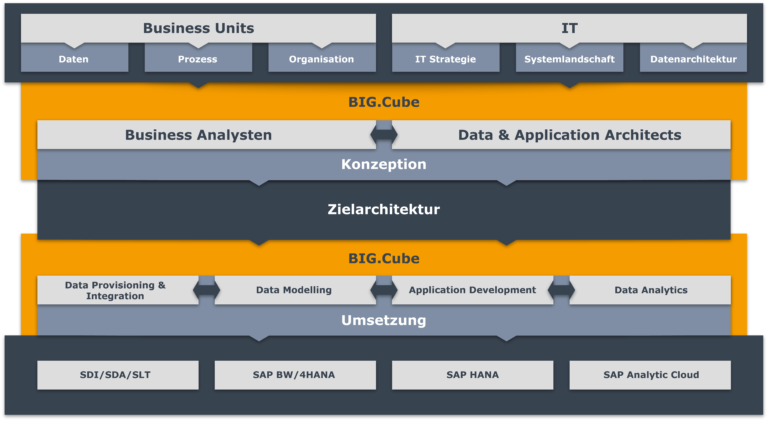How Data Governance and Data Management are Interdependent
The amount and importance of data for companies is growing day by day. However, the mere collection and storage of data is not enough to secure competitive advantages. In order to achieve added value from the data, it is necessary to control the data by means of Data Governance and Data Management – from the process of creation to the provision of a reliable basis for decision-making. Many companies are therefore currently faced with the task of building up this data competence.
Data Governance as a Central Guideline
Data Governance defines cross-organisational roles and responsibilities and associated decision rights and guidelines for quality-orientated control of Data Management. This ensures that Data Governance is anchored in the concrete business processes.
BIG.Cube Data Governance Framework
Companies are often not completely at the beginning in terms of Data Governance. In the different departments of the company, activities have already been established that can be assigned to Data Governance. The problem here is often the lack of transparency and the lack of overarching coordination of these activities.
The Goal in Sight
The Challenges
The implementation of a Data Governance program usually involves a realignment. In order to optimise Data Management across the company, the data is placed in the centre. In addition, a Data Governance organisation will be established and given authority to issue directives. Accordingly, we repeatedly encounter the following main challenges with our clients:
Data Governance – It's Nothing without Data Quality
We implement Data Governance strategies, concepts and processes in your SAP system landscape in such a way that the quality of your data is permanently ensured by means of IT automation.
Data Governance in SAP Analytics
Our Project Approach
Business Analysis
Our business analyst team speaks the language of the business units and understands the meaning of the data, the flow of the processes and the structure of the organisation.
Architecture
Our architects are experts in building system and data architectures in the SAP Business Intelligence world and advise our clients' IT on strategic IT issues. Together with our business analysts, you develop the functional and technical concept for the target architecture and hand over the results into the hands of our implementation experts.
Data Provisioning & Integration
The implementation is holistic, starting with the collection and consolidation of the data by our Data Provisioning & Integration team, which has years of experience in the SAP Data Provisioning Tools SDI, SDA and SLT.
SAP Analytics
Our SAP BW experts model the data in the clients' SAP BW system and ensure an optimised update of the data so that it is made available by our SAP Analytics team in dashboards and reports in the SAP Analytics Cloud (SAC) according to the clients' requirements.
Application Development
Experience shows that clients have additional requirements, such as interfaces to other systems. These are implemented by our developers in the Application Development team according to requirements.
Data Quality
Data Quality is the focus of all data-driven companies. For this reason, we recommend that our clients set up a data quality layer, which all data must pass through in their processing, as early as the conception of the target architecture. The core component of this layer is our DQ product Q-THOR, which sustainably ensures data quality through real-time quality checks.
A Data Governance program focuses on data and its value for the company, so organisational, process and system changes must result from this.
Premium Consultancy for Data Governance & Data Management
From many client projects, we know the strategic drivers for Data Governance programs. We have also advised on setting up the Data Governance organisation and are at home in the disciplines of Data Management. Furthermore, we have developed our own product, Q-THOR, to ensure data quality in companies.

